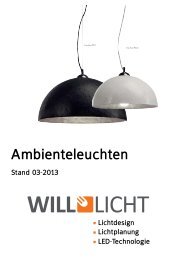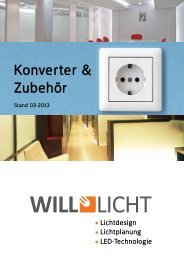LED Steuerungstechnik / eldoLED 2013
Steuerungskomponenten von eldoLED in Perfektion! Dimmen wie man es schon immer gewohnt ist, nur jetzt mit LED.
Steuerungskomponenten von eldoLED in Perfektion! Dimmen wie man es schon immer gewohnt ist, nur jetzt mit LED.
You also want an ePaper? Increase the reach of your titles
YUMPU automatically turns print PDFs into web optimized ePapers that Google loves.
Datasheet DALI-to-DMX Bridge<br />
Accessories<br />
DALI-to-DMX Bridge<br />
eldo<strong>LED</strong> bridges<br />
eldo<strong>LED</strong> network features are based on the LedSync protocol.<br />
All eldo<strong>LED</strong> products support LedSync and have built-in DMX<br />
compatibility. A number of bridges are offered that allow (1)<br />
the default LedSync/DMX universe to communicate with other<br />
network protocols such as DALI and 0-10V, or (2) networking<br />
over RF instead of wired solutions.<br />
DALI-to-DMX bridge<br />
The eldo<strong>LED</strong> DALI-to-DMX bridge translates up to 32 DALI<br />
ballast values into DMX signals. The bridge is ideally suited to<br />
extend existing DALI lighting installations with a DMX universe,<br />
combining the best of both worlds in one hybrid network<br />
consisting of DALI and DMX luminaires.<br />
The bridge’s input side is completely DALI-compatible, meaning<br />
you can use all popular DALI control devices and commissioning<br />
tools to control and configure groups and scenes in<br />
DALI the way you are used to.<br />
The advantages of the DMX output side of the DALI-to-DMX<br />
bridge include the possibility of c hoosing the network resolution<br />
and using the same DMX address for multiple luminaires.<br />
The DALI-to-DMX bridge autoconfigures the number of DMX<br />
channels to the number of configured DALI ballasts.<br />
Configuring network resolution on DMX side<br />
DMX network resolution (number of bits used to send a set<br />
point over the network) can be set to either 8 or 16 bit via the<br />
bridge’s DIP switch. In 8-bit mode, every DALI ballast value is<br />
translated into one 8-bit DMX channel. In 16-bit mode, two<br />
DMX channels are used per DALI ballast value. 16-bit mode<br />
enables a 15-bit resolution fade, resulting in a smooth transition<br />
between set points, invisible to the human eye.<br />
Broadcast mode for daisy-chaining<br />
The bridge broadcasts and replicates the DALI ballast settings<br />
over a maximum of 256 DMX channels with a 16ms update<br />
rate. The broadcast mode and set point replication gives you<br />
the advantage of daisy-chaining and auto-addressing luminaires,<br />
which is especially useful when networking over long<br />
cable distances.<br />
The DALI-to-DMX bridge<br />
Allocating a start address to multiple luminaires<br />
Grouping luminaires with exactly the same behavior is easy in<br />
DMX. All it takes is setting those luminaires to the same DMX<br />
start address. In short, combining the advantages of DALI and<br />
DMX allows you to build a far larger yet easy-to-control network.<br />
Form factor<br />
The DALI-to-DMX bridge measures 68mm by 50mm or<br />
2.68” by 1.97”. DIN rail clip and backing plate are available for<br />
easy installation in standard electric boxes.<br />
Features<br />
• Conversion of 32 DALI ballasts into DMX512-compatible<br />
signals<br />
• Broadcast and replication mode<br />
• Operating supply voltage range: 12V - 32V DC<br />
• DMX network resolution configurable by way of DIP switch<br />
Advantages<br />
• Enables hybrid DALI-DMX network<br />
• Allows daisy-chaining /auto-addressing of luminaires<br />
• Smooth transition between set points<br />
• Easy connection of power, DALI and DMX<br />
• Easy setup and installation<br />
© 2009 eldo<strong>LED</strong>. All rights reserved.<br />
For more information, visit www.eldoled.com










